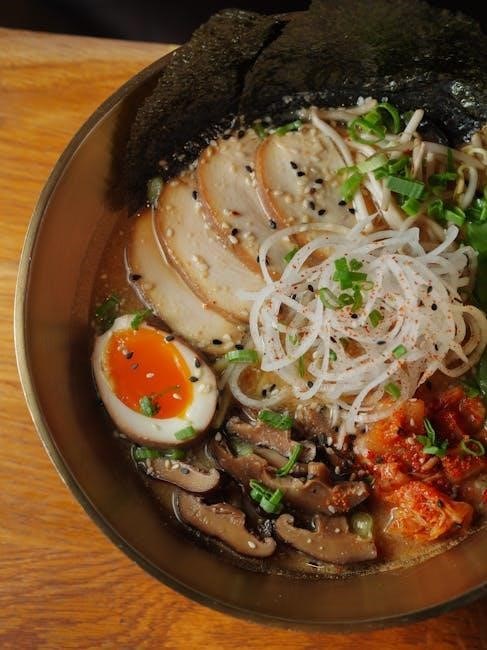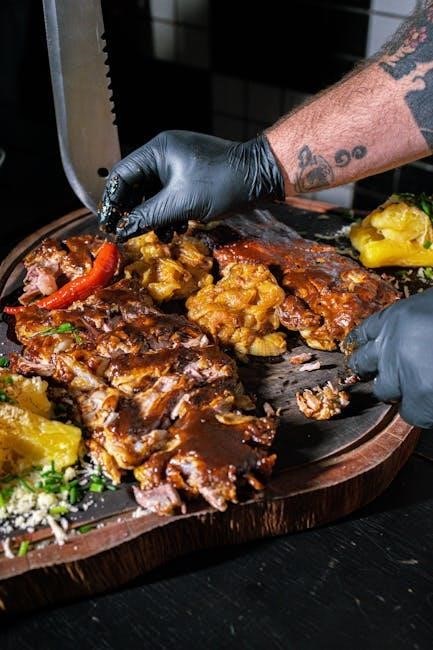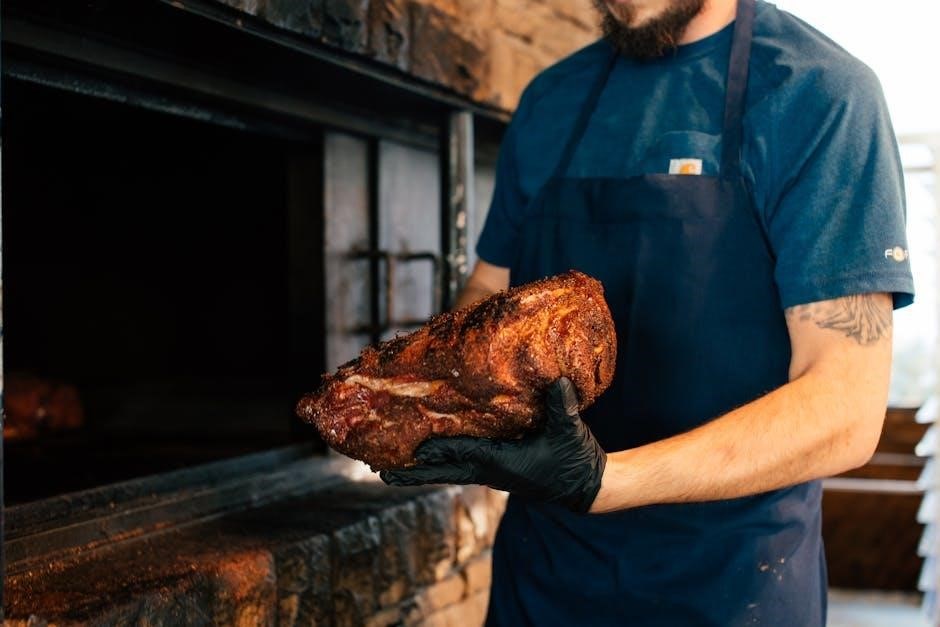Pork Schnitzel Roll is a delicious, crispy German dish made from tender pork loin, breaded and fried to perfection, offering a satisfying comfort food experience.
1.1 Definition and Origin
Pork Schnitzel Roll is a German-inspired dish featuring tender pork loin pounded thin, breaded, and fried to a golden crisp. Originating in Europe, schnitzel has deep roots in German and Austrian cuisines, with “Schweine Schnitzel” being a beloved traditional meal. The roll variation involves wrapping the schnitzel around fillings, creating a hearty, flavorful dish. Its popularity stems from its simplicity and rich, satisfying taste, making it a staple in both home cooking and fine dining across Central Europe and beyond.
1.2 Popularity and Cultural Significance
Pork Schnitzel Roll has become a global culinary favorite, cherished for its crispy exterior and tender, juicy interior. Its origins in German and Austrian cuisines have made it a cultural icon, symbolizing hearty comfort food. Often served in casual eateries and fine dining restaurants alike, it represents a bridge between tradition and modern tastes. The dish’s adaptability to various fillings and sides has broadened its appeal, making it a staple in many households and a star of festive gatherings, embodying the warmth and richness of European gastronomy.

Ingredients Required
Pork cutlets, flour, eggs, breadcrumbs, seasonings, and cooking oil are essential. Optional additions include herbs, cheese, or spices for enhanced flavor in the schnitzel roll.
2.1 Pork Cutlets Selection and Preparation
Select boneless pork loin chops or cutlets, preferably medallion-shaped with minimal fat. Trim excess fat for even cooking. Lay cutlets between plastic wrap and pound thinly using the flat side of a meat mallet to ensure uniform thickness. This step tenderizes the meat and prepares it for breading. Avoid over-pounding to maintain structure. Pat dry with paper towels to remove moisture, ensuring better adhesion of the breading. Proper preparation ensures crisp, even frying and a tender interior in the final schnitzel roll.
2.2 Breading Components (Flour, Eggs, Breadcrumbs)
The breading process requires three key components: all-purpose flour, beaten eggs mixed with milk or water, and breadcrumbs. Seasoned flour adds flavor and texture, while the egg mixture ensures the breadcrumbs adhere evenly to the meat. Panko breadcrumbs are ideal for their light, crispy texture. For extra crispiness, season each layer lightly with salt and spices. Proper breading is essential for achieving the signature golden, crunchy exterior of the schnitzel roll. Avoid over-breading to maintain the delicate balance between meat and coating. This step is crucial for the dish’s texture and visual appeal.
2.3 Seasonings and Marinades
Seasonings and marinades enhance the flavor of pork schnitzel rolls. Common seasonings include salt, black pepper, garlic powder, and paprika. For added zing, lemon juice or zest can be incorporated. Marinating the pork in a mixture of salt, lemon juice, and spices before breading ensures tenderization and depth of flavor. Some recipes suggest marinating for at least 30 minutes to allow the meat to absorb the flavors fully. These steps ensure the schnitzel roll is aromatic and savory, with a balanced blend of spices that complement the crispy exterior and juicy interior.
2.4 Cooking Oil and Equipment
Choosing the right cooking oil and equipment is crucial for achieving a crispy, golden schnitzel roll. Vegetable oil or sunflower oil is ideal due to their high smoke points, ensuring even frying. A large skillet or frying pan with deep sides is recommended to prevent oil splatter. A thermometer is helpful to maintain the perfect frying temperature (325°F to 350°F). Avoid overcrowding the pan, as this lowers the oil temperature and results in greasy meat. A wire rack placed over a plate or tray is essential for draining excess oil after frying, keeping the schnitzel roll crispy and fresh.
Step-by-Step Cooking Process
Pork schnitzel roll transforms pork cutlets into a crispy, flavorful dish through tenderizing, breading, frying, and assembling, ensuring a satisfying meal with each golden, crunchy bite.
3.1 Preparing the Pork Cutlets
Begin by selecting boneless pork loin chops or cutlets, ensuring they are evenly thick. Place each cutlet between plastic wrap and gently pound using the flat side of a meat mallet until about 1/4 inch thick. This step ensures uniform cooking and tender results. Trim any excess fat or connective tissue for a cleaner texture. Lightly pat the cutlets dry with paper towels to remove moisture, which helps the breading adhere better. Proper preparation sets the foundation for a crispy, flavorful schnitzel roll.

3.2 Breading the Pork Cutlets
Dredge the prepared pork cutlets in seasoned flour, ensuring even coverage. Dip each floured cutlet in a mixture of lightly beaten eggs and a splash of water, coating thoroughly. Finally, coat the cutlets in breadcrumbs, pressing gently to ensure adhesion. Season every layer for enhanced flavor. For an extra-crispy texture, let the breaded cutlets rest for 10-15 minutes before frying. This step allows the coating to set, ensuring it stays intact during cooking. Avoid over-handling to prevent the breading from falling off. Proper breading is key to achieving the signature crispy exterior of a perfect schnitzel roll.
3.3 Frying the Schnitzel
Heat a skillet with about 1/2 inch of vegetable or canola oil over medium-high heat until it reaches 350°F. Carefully place the breaded pork cutlets in the skillet, ensuring not to overcrowd it. Cook for 3-4 minutes on each side, or until golden brown and crispy. Avoid touching the cutlets while they fry to prevent the breading from falling off. Once cooked, remove the schnitzel with a slotted spoon and place it on a wire rack to drain excess oil; Repeat with remaining cutlets. Proper frying ensures a crispy exterior and a tender interior for the perfect schnitzel roll.
3.4 Assembling the Schnitzel Roll
To assemble the schnitzel roll, place the fried pork schnitzel on a flat surface. Arrange your preferred fillings, such as lettuce, tomato, and a dollop of sauce, neatly along the center of the schnitzel. Brush the edges lightly with water to help seal the roll. Roll the schnitzel gently but firmly, applying even pressure to ensure a tight, compact shape. Secure the roll with toothpicks if needed. Let it rest for a few minutes before slicing. Serve immediately for a crispy, flavorful dish that’s perfect as an appetizer or main course.
Tips for Perfect Schnitzel
Pound cutlets thinly for even cooking and crispy breading. Season every layer and use hot oil for frying to achieve a golden, non-greasy crust effortlessly.
4.1 Achieving Crispy Coating
Achieving a crispy coating on pork schnitzel requires proper breading and frying techniques. Use Panko breadcrumbs for a lighter, crunchier texture. Ensure cutlets are dry before dredging in flour, then dip in beaten eggs, and coat evenly with breadcrumbs. Press gently to adhere. Fry in hot oil (around 350°F) without overcrowding the pan. Avoid moving the schnitzel too much to prevent breaking the crust. Drain on paper towels to remove excess oil. For extra crispiness, bake in a preheated oven at 400°F for 5-10 minutes after frying. This ensures a golden, non-greasy finish.
4.2 Avoiding Common Mistakes
Common mistakes when cooking pork schnitzel roll include overcrowding the pan, which lowers oil temperature and leads to greasy results. Ensure cutlets are at room temperature before frying for even cooking. Avoid over-handling the meat during breading, as it can compress the coating. Use the correct oil temperature (around 350°F) to prevent burning. Don’t skip seasoning layers, as it enhances flavor. Over-pounding the meat can make it too thin and fragile. Let the coated schnitzel rest for a few minutes before frying to set the breading. These tips ensure a crispy, flavorful, and perfectly cooked schnitzel roll every time.

Variations and Serving Suggestions
Pork Schnitzel Roll can be served traditionally with lemon wedges, fries, or salad, or modernized with herbed butter, garlic sauce, or paired with roasted vegetables.
5;1 Traditional German Serving Styles
Traditionally, Pork Schnitzel Roll is served with a squeeze of fresh lemon, crispy fries, or a refreshing side salad. Germans often pair it with tartar sauce or a light cucumber salad for balance. Another classic combination is serving it with braised red cabbage or sauerkraut, adding a tangy contrast to the rich, crispy pork. For a hearty meal, it’s also paired with buttery spaetzle or mashed potatoes. The dish is often garnished with chopped parsley and served hot, straight from the skillet, ensuring a crispy texture and flavorful experience that reflects authentic German cuisine.

5.2 Modern Twists and Accompaniments
Modern twists on Pork Schnitzel Roll include innovative sauces like sriracha mayo or teriyaki glaze for a fusion flavor. It’s often paired with contemporary sides such as roasted vegetables or quinoa for a lighter meal. Some chefs add unique ingredients like garlic parmesan to the breading for extra flavor. Low-carb versions substitute breadcrumbs with almond flour, while others experiment with air frying for a healthier alternative. Experimenting with global spices, like Korean chili flakes, adds a bold twist. These modern interpretations keep the dish exciting while maintaining its crispy, savory essence that fans of the classic version love.

Storage and Reheating

Store Pork Schnitzel Roll in an airtight container in the refrigerator for up to 3 days. For reheating, use an oven or air fryer at 350°F (175°C) until crispy.
6.1 Keeping Schnitzel Fresh
To maintain freshness, store Pork Schnitzel Roll in an airtight container in the refrigerator within two hours of cooking. Keep it on a paper towel-lined plate to absorb moisture. For longer storage, wrap tightly in plastic wrap or aluminum foil and refrigerate for up to three days. Freezing is also an option; place the schnitzel in a freezer-safe bag or container and store for up to three months. Ensure no air is trapped to prevent freezer burn; Always reheat thoroughly before serving for optimal texture and flavor.
6.2 Best Reheating Methods
For a crispy reheated Pork Schnitzel Roll, preheat your oven to 375°F (190°C). Place the schnitzel on a wire rack-lined baking sheet, ensuring air circulates evenly. Drizzle lightly with oil and bake for 10-15 minutes. Alternatively, pan-fry in a skillet with a small amount of oil over medium heat, cooking for 3-4 minutes per side. Avoid microwaving to prevent sogginess. For frozen schnitzel, thaw overnight in the fridge before reheating. Always reheat until golden and crispy to restore its original texture and flavor.
